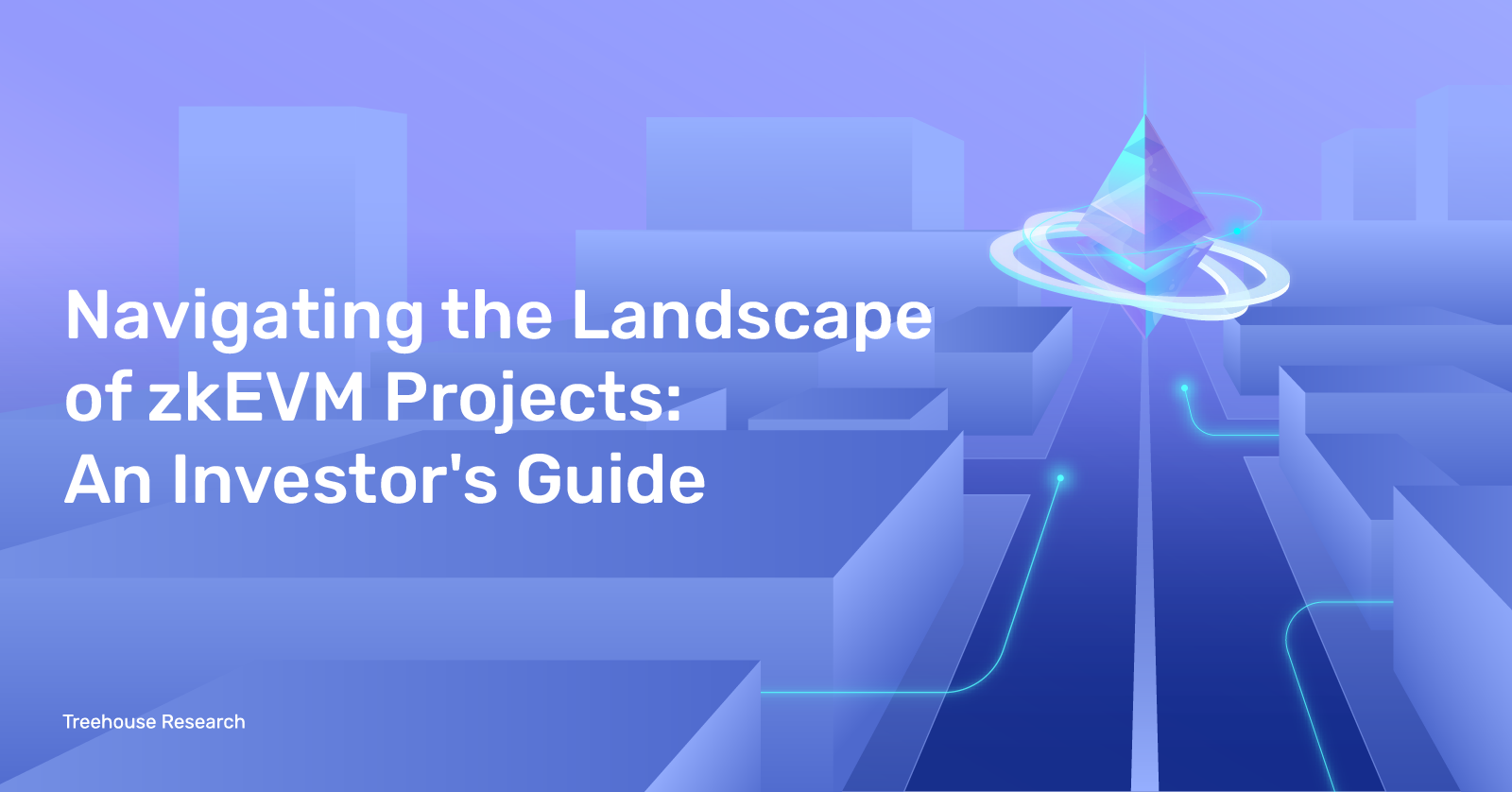 Co-Authored with David Toh, Partner at Mirana Ventures
Co-Authored with David Toh, Partner at Mirana Ventures
Introduction
Picture the Ethereum Chain as a bustling city highway; the developments in Layer-2s, like Arbitrum, and the network upgrade, such as the Shapella upgrade, are like snazzy new road expansions and slick flyovers, easing traffic and letting transactions zoom by faster. It’s a popular city! More and more folks are moving in, bringing a wave of other buildings (decentralized apps). Suddenly, our superhighway isn’t so super anymore. It’s crammed with traffic (transactions), and you have to consume a lot of fuel (gas fees) being stuck in peak-hour traffic. Not cool. Enter zero-knowledge proofs (ZKPs). They’re the cool traffic management system we need, capable of handling more transactions on the chain without spilling everyone’s secrets. So, buckle up and get ready for a smoother ride in Ethereum City!
So What Are Zero-Knowledge Proofs (ZKPs)?
ZKPs are an innovative mathematical approach that facilitates the verification of information, crucially, without exposing the underlying data. This type of cryptographic protocol allows the prover to validate the truth of a statement to the verifier, all while maintaining the secrecy of any additional information.
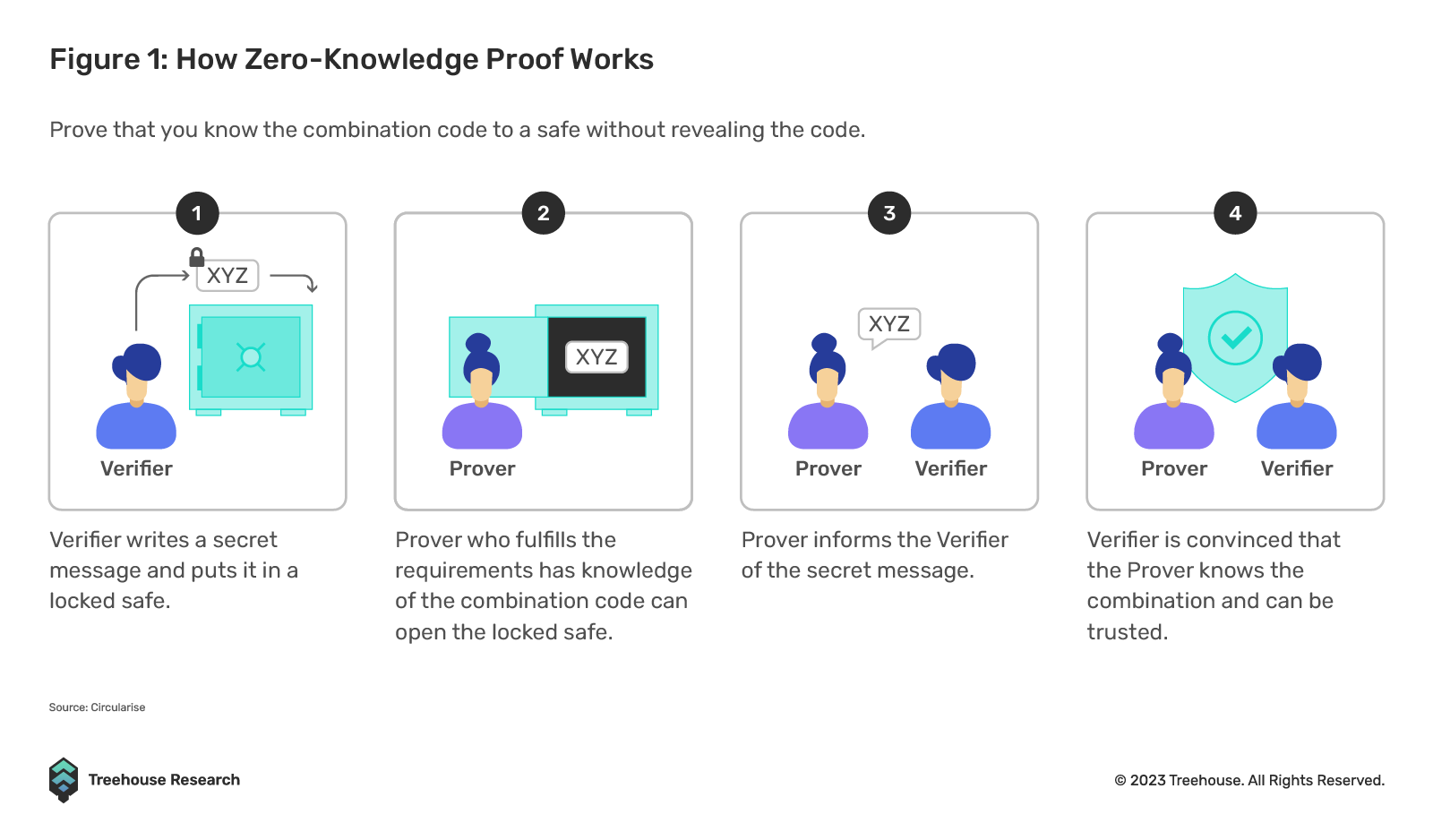
Imagine a game of poker. ZKPs are like showing you have the winning hand, but without revealing your cards. You can prove you’re the winner (prover), and the other players (verifiers) can accept this, all while your specific cards remain a secret.
What are zk-SNARKS and zk-STARKs?
Having navigated the fascinating realm of Zero-Knowledge Proofs (ZKPs), it’s time to delve deeper into two of its most intriguing subsets: SNARKs (Zero-Knowledge Succinct Non-Interactive Argument of Knowledge) and STARKs (Zero-Knowledge Scalable Transparent Argument of Knowledge). These aren’t just fancy acronyms; they’re specific types of ZKPs that play a pivotal role in the world of ZK projects we’re exploring.
SNARKs and STARKs, while sharing the foundational principles of ZKPs, each bring their unique attributes to the table.
zk-SNARKs and zk-STARKs are cryptographic proofs, allowing you to prove that certain information is accurate without revealing the data itself – this is the “zero-knowledge” part. They help ensure privacy and efficiency in verifying complex computations.
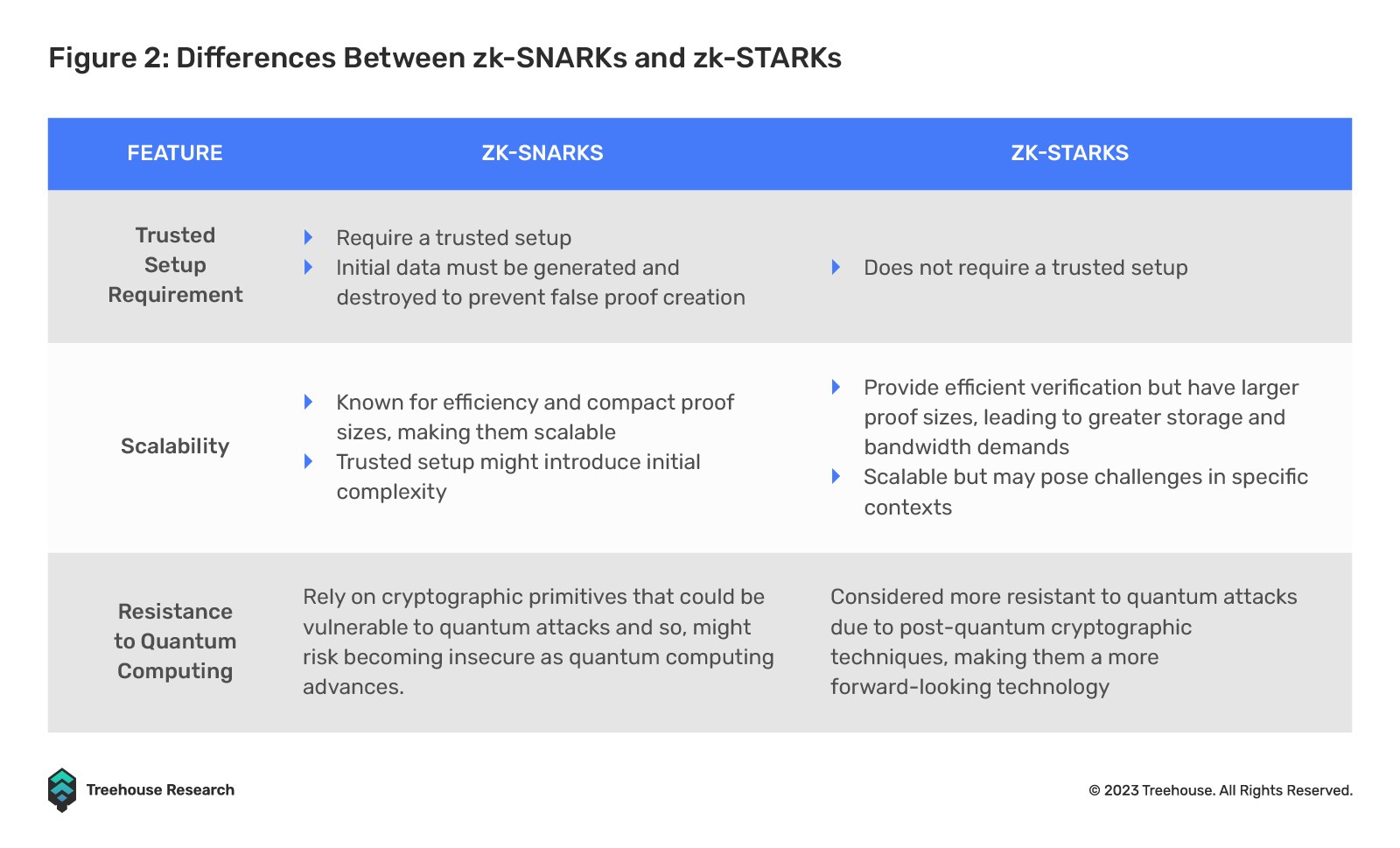
* For more detailed explanations of how zk-SNARKs and zk-STARKs work, please refer to Appendix 1 and 2 at the end of this article.
| Is there a distinct advantage between these 2 subsets? While both zk-STARKs and zk-SNARKs serve the purpose of enabling zero-knowledge proofs, they come with their own sets of advantages and trade-offs. The choice between them often depends on the specific requirements of a project. If trustworthiness and post-quantum security are paramount, zk-STARKs might be preferred. On the other hand, if efficiency and speed are more critical, zk-SNARKs could be the better choice. They’re not merely “different”; their distinctions have practical implications for their applications in the real world. |
Zk-rollups
Rollups: The Scaling Solution
As mentioned, in a traditional blockchain system such as Ethereum, the transaction verification process limits how much the network can grow or “scale”. When a lot of people are trying to make transactions at once, the network can get overloaded, leading to high transaction costs. This issue challenges the goal of creating a network that can grow and remain decentralized. When it comes to Ethereum’s scalability challenge, it has witnessed the emergence of several innovative solutions, most notably: “rollups” or Layer 2s (L2s).
Rollups, simply put, process and validate transactions off-chain before consolidating and uploading them as a single batch on the mainchain. Imagine you’re sending letters to your friends. You could send each letter individually, but that’s a lot of trips to the post office, right? Instead, you decide to put all the letters in one big envelope and send them to the postman in one go. That’s exactly what rollups do! They take a bunch of transactions, bundle them up into one neat package, and send them off to the Ethereum mainchain. It’s like express delivery for your transactions.
Like express delivery services for letters, rollups streamline and enhance the Ethereum blockchain’s transaction process. While traditional Ethereum transactions are transparent and verifiable by all, they can sometimes be cumbersome and lack privacy. zkEVMs (Zero-Knowledge Ethereum Virtual Machines) introduce a layer of cryptographic sophistication, allowing transactions to be validated without revealing their specific details. This not only bolsters transaction privacy but also optimizes the Ethereum network’s efficiency by reducing the computational resources needed for transaction verifications.
Optimistic vs. Zero-Knowledge Rollups
Now, let’s talk about the two types of rollups: Optimistic Rollups (ORUs) and Zero-Knowledge Rollups (ZKRs). They’re like two different delivery services on the EVM highway, each with its own way of doing things.
An Optimistic Rollup is like a trusty old postal service that assumes every letter (transaction) is addressed correctly. This post is pretty quick and can avoid most of the traffic on the highway. They believe all transactions are valid and only double-check if someone raises a flag. But here’s the catch: it takes a whole week to confirm their validity. Imagine that you have some urgent information that needs to be passed, that’s too long of a wait! Examples of existing optimistic rollups are Mantle, Arbitrum, and Optimism.
On the other hand, a Zero-Knowledge Rollup is like a meticulous courier who checks every detail before delivery. This courier service is also really fast, and they use a special magic ball (validity proofs) to instantly verify transactions, ensuring everything is in order right from the get-go. It’s like having your own personal quality control. Examples of existing zk-rollups are Taiko, Scroll, zkSync Era, Starknet, Polygon zkEVM, and Linea.
So, while ORUs are all about trust and patience, ZKRs are about instant validation and peace of mind. Understanding these differences is key to appreciating the potential of ZKRs. It’s like choosing the right delivery service for your precious package.
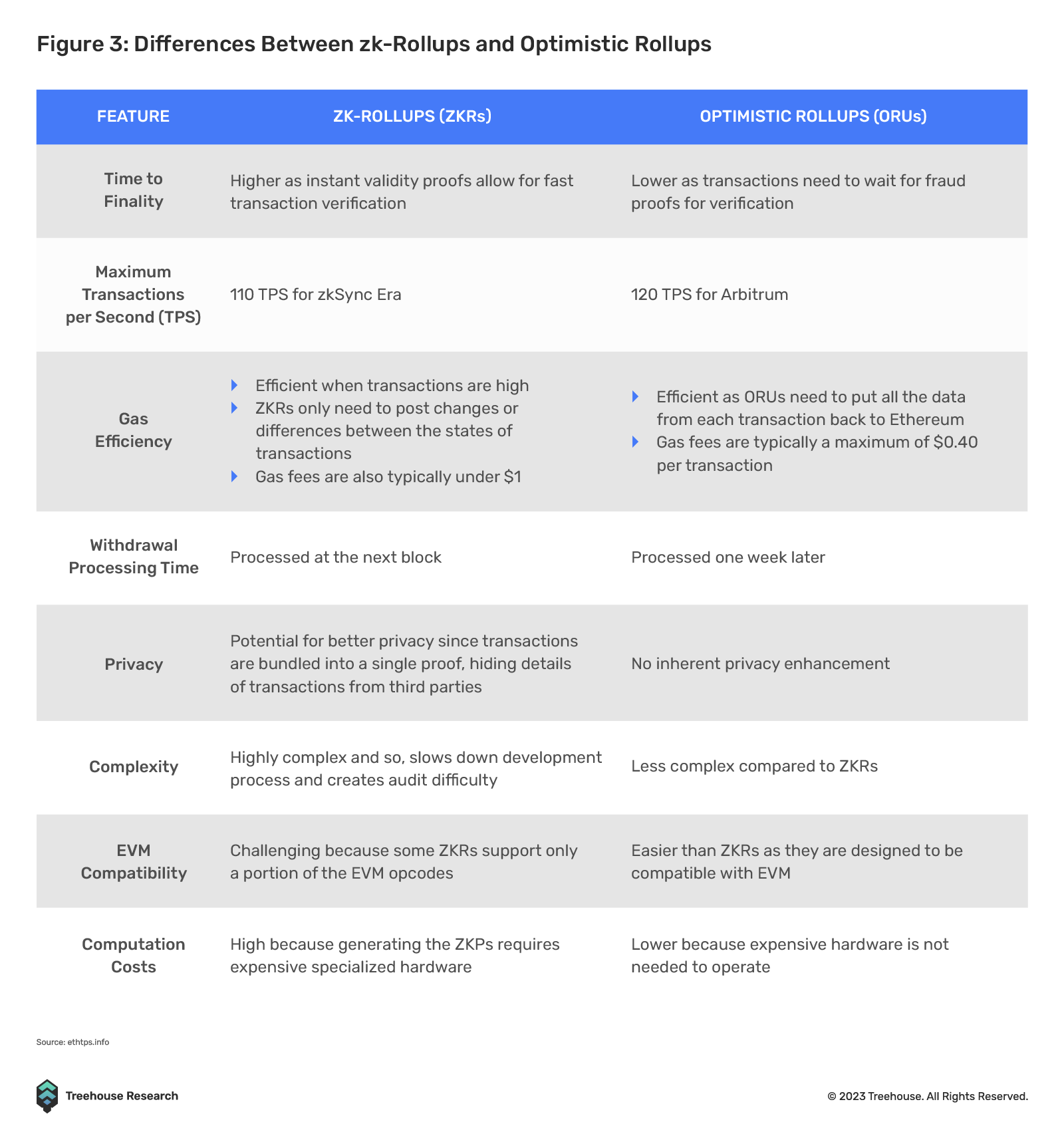
| Other Use Cases Of ZKPs ZKPs, while commonly known as the solution for Ethereum scaling through Layer-2 networks, are also ideal for various kinds of applications in real life, with their primary purpose being to enable honest computation proofs without revealing inputs. For more information on how ZKPs are used outside of Ethereum scaling solutions, please refer to our appendices at the end of this article. |
Zk-rollups on ETH L2 scaling solutions
Zk-rollup solutions are currently being developed by various teams such as Polygon, and zkSync. What exactly are the differences between these zk-rollups?
Gas Fees Visualized
There is evidently a difference between the Gas fees that are consumed by different L2 rollups. zkEVM’s fees are more volatile primarily due to changes in its throughput, leading to more volatile costs. On the other hand, OptimisticEVM fees remain relatively flat because of its consistent challenge-based mechanism, which provides more predictable transaction validation costs. The differing transaction levels and underlying mechanics of the two technologies contribute to the disparity in fee stability.
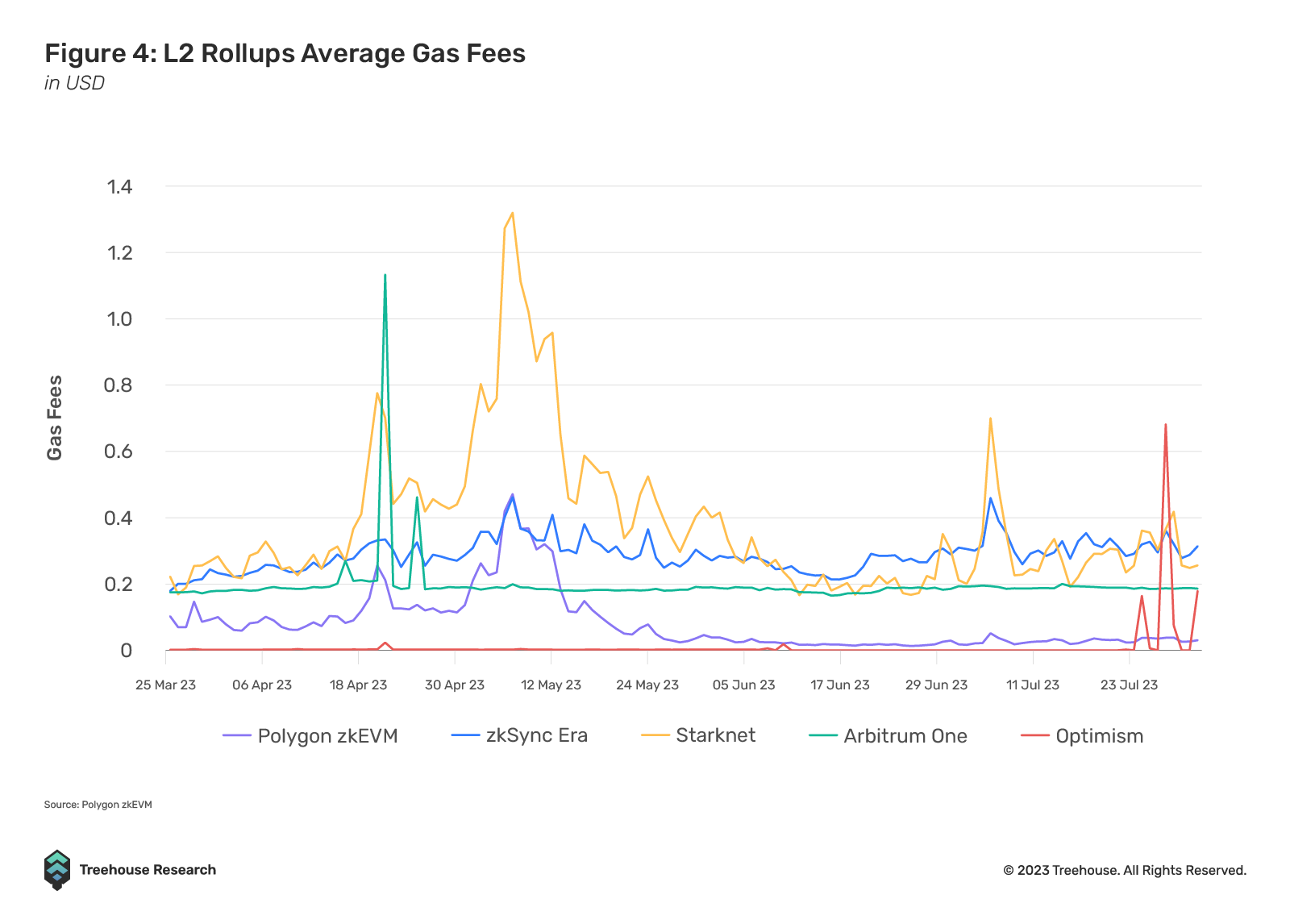
| Can Layer-2 Gas Fees Surpass Ethereum’s? Despite assumptions that L2 fees are low, Optimistic Rollup fees can sometimes exceed those of L1. This occurs due to the nature of how fees are determined: by demand for limited block space. Just as congestion on Ethereum’s main network raises fees, a surge in demand on a Layer-2 can do the same. As seen in the chart, the spikes in Arbitrum and Optimism fees are a clear demonstration of this. During an incentivized user program, Odyssey, on Arbitrum witnessed a deluge of participants hoping to secure potential airdrops. The unexpected traffic outpaced Arbitrum’s capacity, causing fees to soar, at some point even exceeding Ethereum mainnet gas fees. This underscores the fact that while Optimism solutions aim to alleviate congestion, they are not immune to it. It’s a reminder for users and developers alike that scalability remains a nuanced challenge, and no solution is a panacea. |
There is a pronounced divergence between Ethereum’s mainnet fees and Layer-2 fees. Notably, all Layer-2 solutions exhibit average transaction fees surpassing the $1 threshold. When juxtaposed against Ethereum’s main network, the transaction fees are approximately seven times higher than those on Polygon’s zkEVM, a zero-knowledge rollup. This disparity underscores the financial efficiency of Layer-2 solutions, emphasizing their potential value proposition for users seeking cost-effective transaction methods.
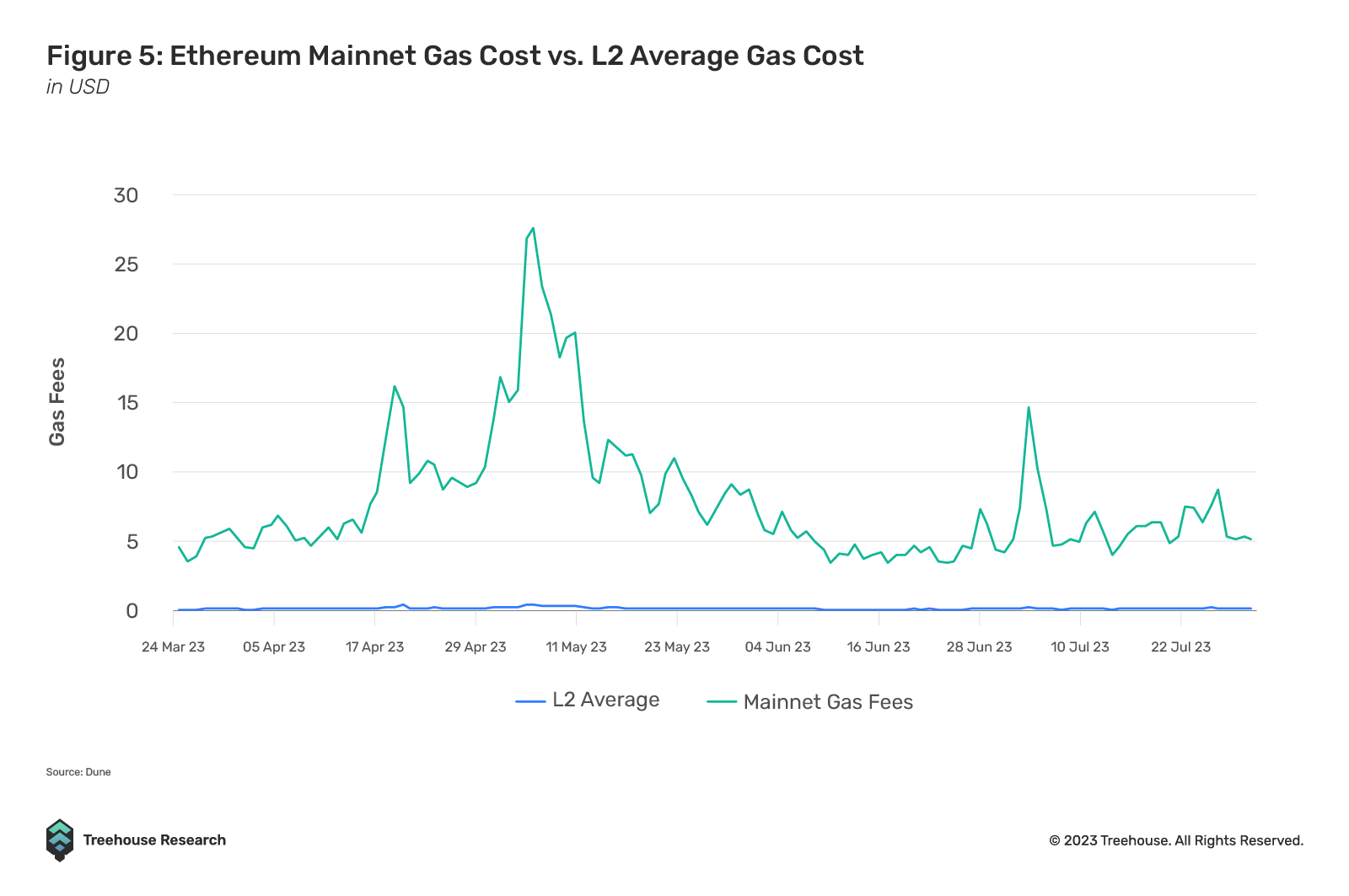
The reason for the disparity is due to an inverse relationship between the daily number of transactions and Gas Fees. Why? As more transactions occur on the zk-rollup, the transaction fees decrease. As more people use zk-rollups, the cost of verifying transactions gets divided among more users, resulting in lower fees per transaction. The inverse relationship between the number of transactions and gas fees makes zk-rollups a more efficient and affordable option, especially when the network is busy. Therefore, as an investor, you can use zk-rollups when the traffic is higher in order to pay a lower fee for transactions.
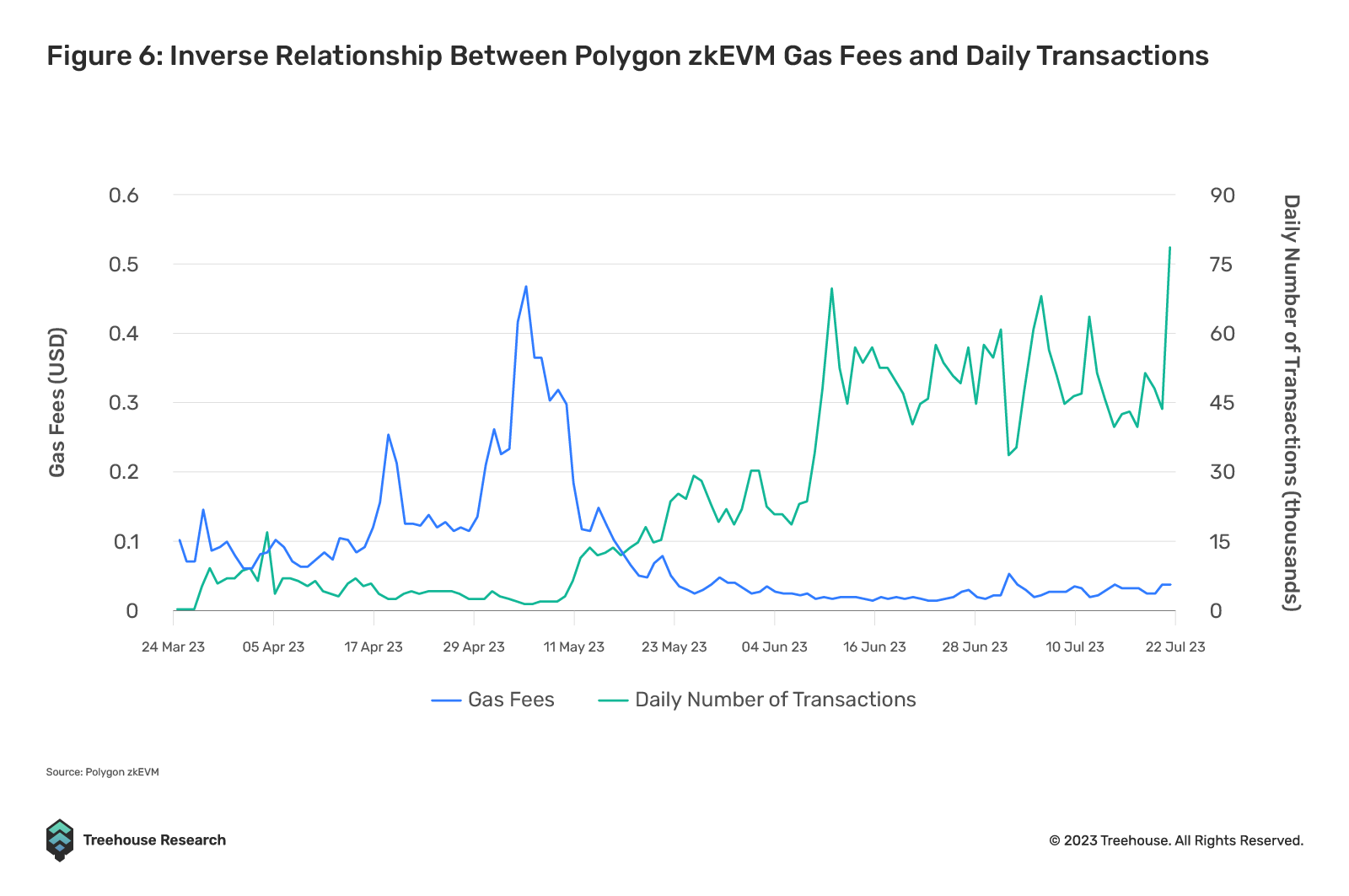
| Not all zk-rollups are made equal While we see that zk-rollups like Starknet and zkSync trying to keep fees lower than Arbitrum, Polygon zkEVM distinguishes itself from other zkEVMs by maintaining lower transaction fees, rivaling Optimism for the lowest average fees amongst the L2s. This competitive edge is attributed to Polygon’s optimized infrastructure, strategic scalability solutions, and a consensus mechanism tailored for cost-efficiency. Additionally, its emphasis on interoperability and developer incentives ensures a streamlined and cost-effective ecosystem. Consequently, for investors and users seeking a balance between performance and cost in the L2 space, Polygon’s approach offers a compelling value proposition in the rapidly evolving DeFi sector. |
Categorization of zkEVMs
While we’ve delved deeply into the domain of rollups, touching on zk-rollups and their impact on the Ethereum network, it’s also crucial to understand that you can also call Ethereum-based zk-rollups zkEVMs. zkEVM, or Zero-Knowledge Ethereum Virtual Machine, represents a new frontier in Ethereum’s scalability solutions, striving to maintain the network’s security while optimizing its throughput.
Vitalik Buterin has categorized zkEVMs into four types based on their compatibility with the Ethereum Virtual Machine (EVM) and their prover time.
A key concern that arises when attempting to leverage the features of the EVM is that it operates as a stack of data and state transitions, which are computed operations. The implementation of a zkEVM would necessitate the incorporation of a zero-knowledge circuit to validate the accuracy of processed transactions.
The most direct approach suggests tailoring the lower-level aspects of the virtual machine to accommodate this circuit. However, this would result in a trade-off, leading to a potential loss of access to the pre-existing tools and infrastructure designed for the EVM.
Various strategies perceive this issue to varying degrees of depth, and developers and builders are seeking access to a novel version of the EVM that possesses Ethereum-like properties while also capitalizing on the scalability benefits of zk-rollups.
- Type 1 zkEVMs are fully Ethereum-equivalent and have perfect compatibility, but slow prover times.
- Type 2 zkEVMs are fully EVM-equivalent but not Ethereum-equivalent and have improved but still slow prover times.
- Type 3 zkEVMs are almost EVM-equivalent, making them easier to build, but more incompatible with faster prover times than Type 1 and 2.
- Type 4 zkEVMs are high-level-language equivalent with very fast prover times but have even more incompatibility.
Currently, many different projects are exploring the combinations of these different tradeoffs, with no definitive answers to which of the four types is necessarily superior to the others. It’s also important to note that zkEVM projects can develop and shift to lower or higher numbered types over time as they change and upgrade their fundamental infrastructure.
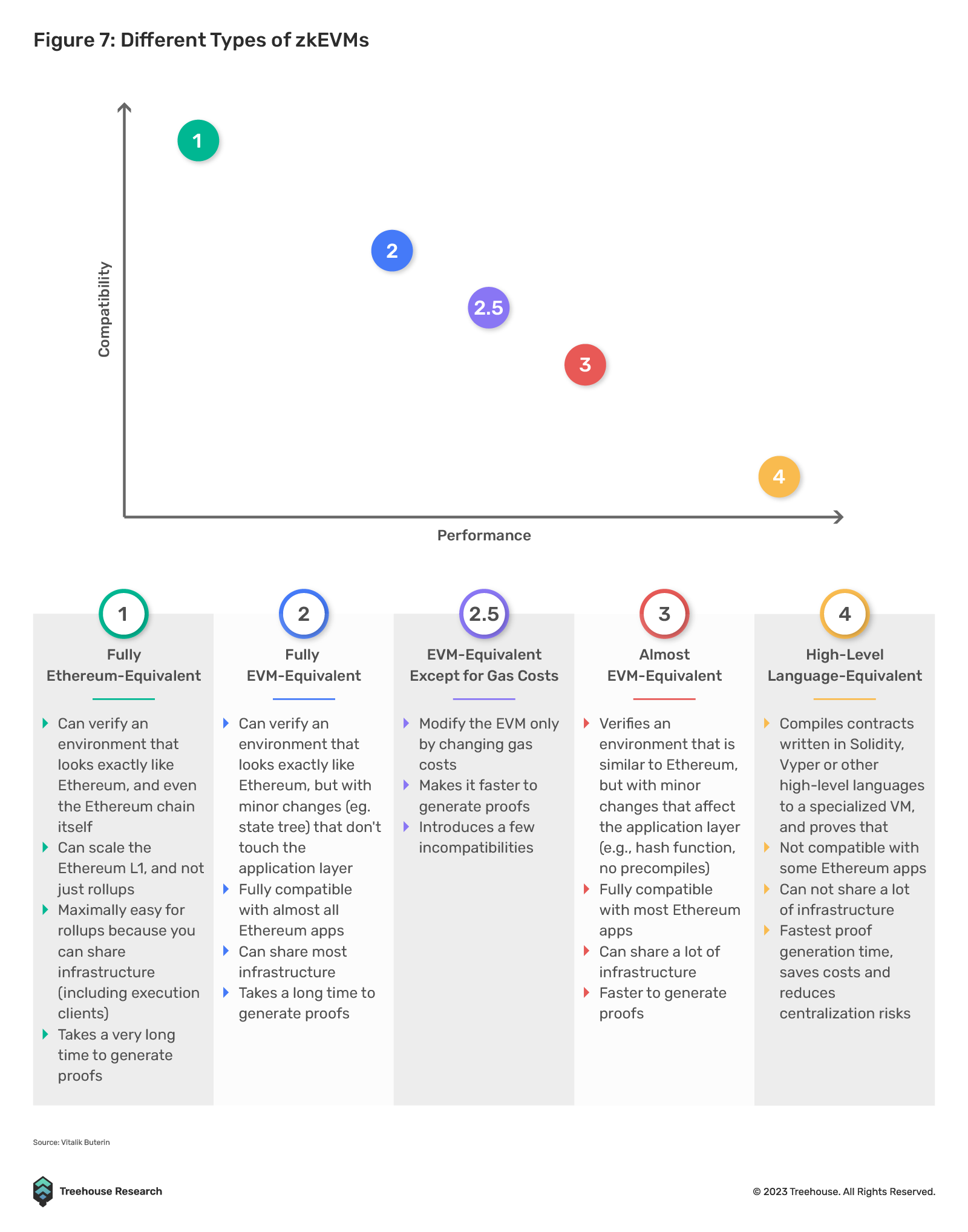
zkEVM Projects
As we have highlighted, not all zkEVMs are equal. There are several factors to consider when one joins their respective ecosystems. These projects differ in the type of EVM compatibility, the underlying ZK technology used, and TVL data. Let’s dive deeper into some of the most well-known zkEVMs on the market.
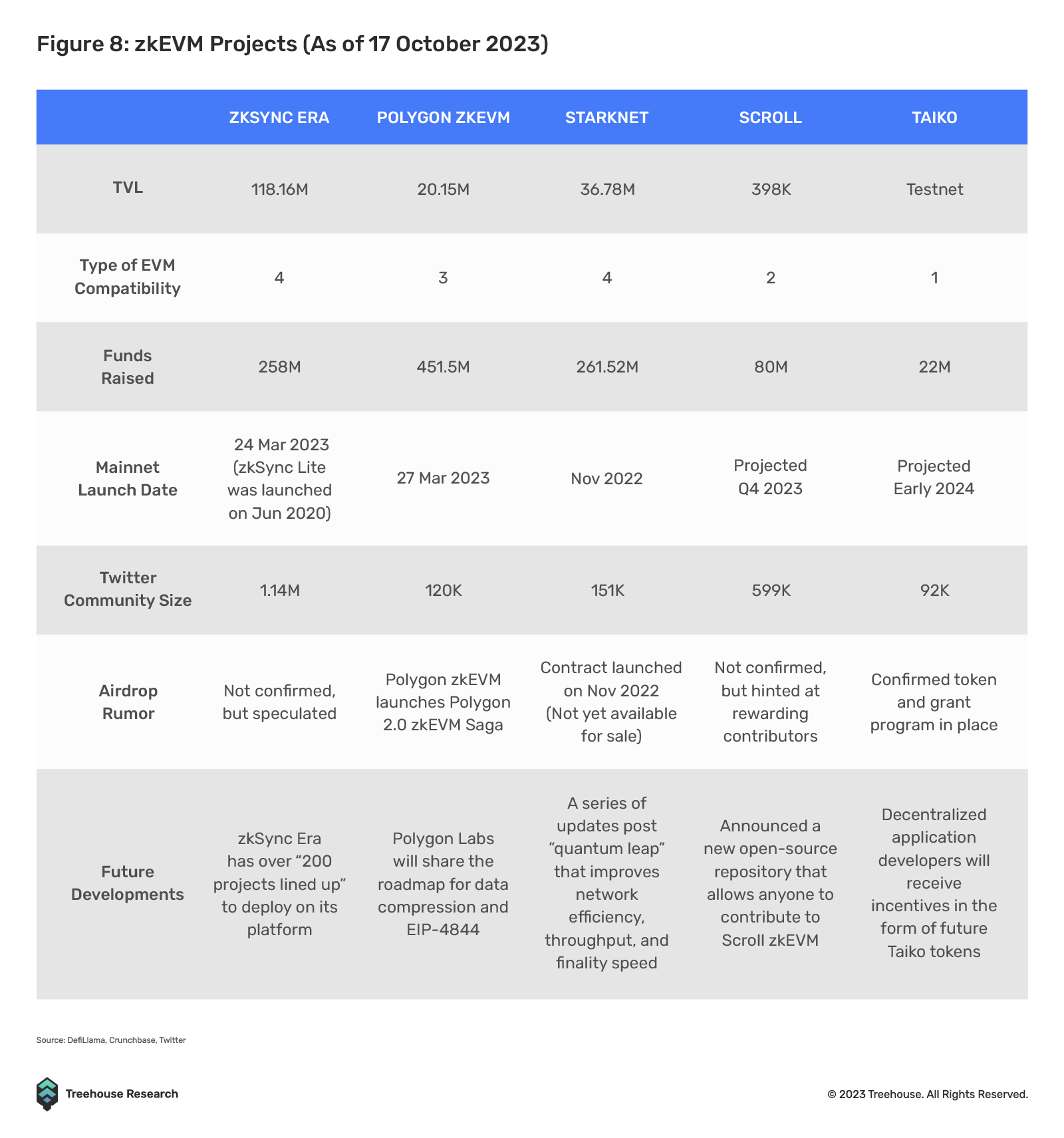
zkSync’s Market Dominance: Reasons and Implications
As seen from the table, ZkSync Era dominates the zkEVM landscape with a TVL of $118.16M, followed by Starknet at $36.78M and Polygon zkEVM at $20.15M. Scroll also launched their mainnet just days ago, with multiple dApps like Skydrome already attracting hundreds of thousands in TVL. zkEVM launched its mainnet in November 2022, ZkSync Era on March 24, 2023 (with its Lite version operational since June 2020), and Polygon on March 27, 2023. Taiko is projected to launch in early 2024.
When it comes to market dominance, zkSync holds a strong position as it currently maintains the highest TVL and stands as the most mature zkEVM chain by a large margin. zkSync’s first-mover advantage undoubtedly provides it with a certain edge, but the popularity of zkSync is a result of more than just being first to market.
Adding to the intrigue surrounding ZkSync Era is the persistent rumor of an impending airdrop. Given the substantial fundraising the firm has achieved, market participants and users are anticipating a token-based incentive to further engage with the platform. Such a move, if realized, could further bolster ZkSync’s market position, rewarding early adopters and attracting new users to its ecosystem.
However, it is important to remember that the defensibility of zkSync against up-and-coming players is not guaranteed, as the technology landscape is constantly evolving. Additionally, zkSync is also a Type-4 zkEVM, which means that they have a lower EVM compatibility than other zkEVMs.
How are the other players advancing towards enhancing blockchain scalability and interoperability?
Other contenders, including Polygon zkEVM and Scroll, though not as far along as zkSync or Starknet in TVL, show promising potential. Polygon zkEVM, with its industry-leading integrations and enterprise orientation, is rapidly gaining traction. Scroll, having launched its mainnet on October 13th, has a direct compilation of Solidity, strong community ethos, and a commitment to open-source development, adding to the robust landscape of zkEVMs.
zkEVMs, in general, like other Layer-2 solutions, also aim to ensure interoperability with other networks by creating communication bridges, smart contracts, and creating or utilizing shared standards.
Polygon, for instance, is expanding the LX-LY bridge, designed to facilitate smooth transactions within its ecosystem. The inherent advantage here is the unified structure, ensuring smooth asset transfers between its platforms, all finalizing on Ethereum.
The landscape of zk-rollups is evolving with the advent of smart contracts that can discern various proof types. To understand the depth of this, consider the unique proof types: Starknet utilizes STARKs, zkSync operates on SNARKs, and Polygon Zero has adopted an innovative approach with recursive SNARKs, termed as PLONKs (fast method to verify many blockchain transactions without revealing their details). Starknet has taken strides in this direction with a contract that can verify a Groth-16 SNARK (very fast verification times and small proof sizes), enabling direct communication with any rollup that uses a similar verification method. The industry is buzzing with anticipation, expecting to soon witness expanded capabilities, especially for PLONKs, which would significantly elevate zkEVM interoperability.
* For more detailed explanations on the differences between Groth-16 and PLONKs, please refer to Appendix 4 at the end of this article.
On top of these protocols, protocols are racing to launch their own zkEVMs. Recently, Consensys introduced the Linea zkEVM, a cutting-edge protocol leveraging zkSNARK technology. Unlike traditional zkSNARKs, Linea employs a lattice-powered prover, eliminating the need for a trusted setup and expediting proof generation. By integrating this approach, transaction costs on the Ethereum mainnet can be reduced by 15x to 20x, signifying a substantial efficiency and economic advantage for users and developers.
Envisioning the future, the adoption and implementation of shared standards could revolutionize interoperability. In the bigger picture, imagine a future where these technologies all speak a common language, similar to how websites today use common protocols. That’s the dream many in the industry have, where varied rollup systems can connect effortlessly, reshaping how we view blockchain scalability.
Zk-rollups In Layer-3 Platforms
In today’s evolving market landscape, zk-rollups are increasingly being tailored for specific applications, or Layer-3. Notably, Loopring focuses on trading and payments, ImmutableX targets the gaming sector, and dYdX stands out with its emphasis on derivatives trading. StarkEx plays a pivotal role in facilitating these applications. The specialization of these zk-rollups underscores the adaptability and potential of this technology, suggesting that as different sectors recognize its benefits, we can anticipate a broader integration of zk-rollups in diverse applications, further solidifying their importance in the decentralized ecosystem.
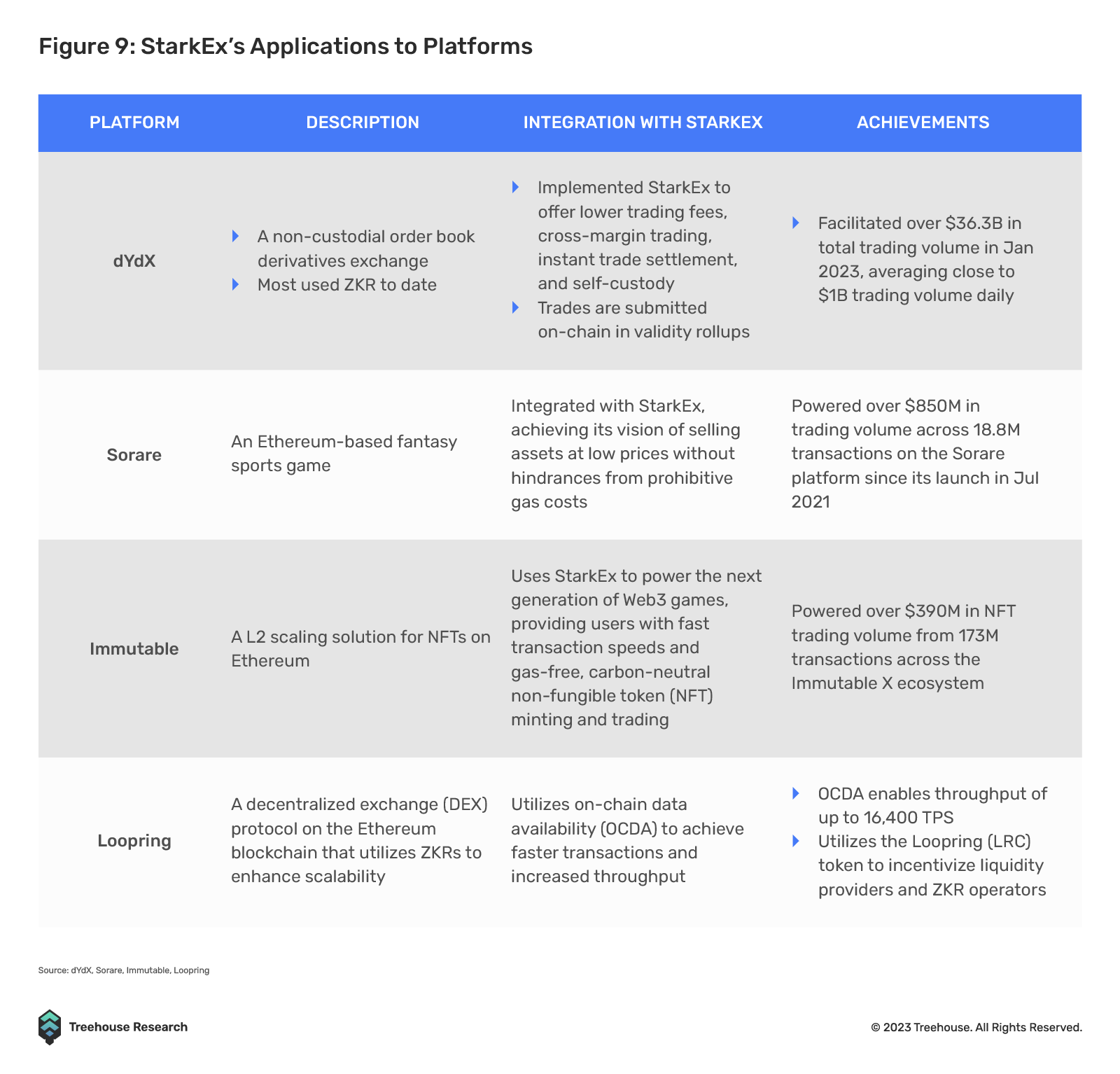
Potential Catalysts for the Growth of zkEVM
Partnerships with Major Players
Collaborations between major companies like Visa and StarkWare signal industry confidence in zkEVM. These partnerships are likely to drive further adoption and innovation. The integration of zkEVM into existing financial systems and its collaboration with leading technology providers showcase its potential to become a mainstream technology.
The development of decentralized apps and platforms built on zkEVM showcases its practical applicability. Real-world adoption is a critical factor in driving growth and acceptance. From payment platforms to loyalty programs, the real-world applications of zkEVM are diverse and growing, reflecting its potential to transform various industries.
Immense Hype Generated From Future Airdrops
Additionally, it’s undeniable that one of the prevailing narratives sweeping through the crypto markets recently has been airdrop hunting. The announcement of Arbitrum’s ARB token airdrop ignited substantial interest in the Ethereum Layer-2 ecosystem, particularly enhancing the appeal of emerging Layer-2 solutions, epitomized by zkSync Era. Although zkSync hasn’t officially released its own token or announced an airdrop, the buzz from Arbitrum’s announcement led many to speculate that zkSync might soon introduce similar incentives. Consequently, zkSync experienced a marked rise in activity, with over 39,000 addresses transferring more than $871 million to the platform in just a week following the ARB revelation, representing a 5x surge.
Subsequently, zkEVM projects have garnered increased attention due to anticipated airdrop opportunities. Should any prominent zkEVMs initiate an airdrop, it will attract significant attention toward the zkEVM sector from the wider market. This influx of interest will likely catalyze further attention, investments, and developer engagement within the ecosystem, mirroring the positive impact the ARB airdrop had on the Arbitrum ecosystem.

Conclusion
The landscape of zkEVM projects is dynamic, innovative, and brimming with potential. As we navigate the complexities of zero-knowledge proofs and their applications in the DeFi space, it’s clear that these technologies are not just transforming the way we approach privacy and scalability. They’re also reshaping the future of Ethereum and the broader blockchain ecosystem.
Each zkEVM project we’ve explored—zkSync, Starknet, Scroll, or others—brings unique offerings. They each have their strengths, challenges, and individual market positions. As investors, it’s crucial to understand these nuances to make informed decisions.
These projects’ potential airdrops and future developments further underscore their exciting opportunities.
As we stand on the cusp of this new era in blockchain technology, one thing is sure: zkEVMs and zero-knowledge proofs will play a pivotal role in the evolution of the DeFi space. As investors and enthusiasts, we have the thrilling opportunity to be part of this journey and witness the transformative power of these technologies firsthand.
We would like to extend our deepest gratitude to David Toh, Partner at Mirana Ventures, for his insights and collaboration on this zkEVM research.
Appendices:
Appendix 1: Workings of SNARKS:
zk-SNARKs (Zero-Knowledge Succinct Non-Interactive Argument of Knowledge) are one of the most well-known types of zero-knowledge proofs. They were first implemented on the cryptocurrency Zcash and use a complex mathematical algorithm called a “pairing” to prove the validity of a statement without revealing any additional information. zk-SNARKs are particularly useful for privacy-sensitive applications, such as the verification of private transactions on a public blockchain.
Prover and Verifier: There are two parties involved in a SNARK proof: a Prover and a Verifier. The Prover wants to prove that a statement is true, while the Verifier wants to validate the proof without knowing any additional information beyond the statement.
Public Parameters: SNARKs require a set of public parameters, which are generated in a setup phase and shared between the Prover and Verifier. The public parameters are used to ensure the privacy and security of the SNARK proof.
Circuit: The Prover and Verifier interact through a circuit, which is a mathematical function that defines the statement to be proven. The circuit inputs are private and only known to the Prover. The outputs of the circuit are public, and they define the statement to be proven.
Proof Generation: The Prover generates a proof by computing the inputs to the circuit, and then generating a proof that is a commitment to the inputs. The proof is short and succinct, making it efficient for the Verifier to validate.
Proof Validation: The Verifier validates the proof by using the public parameters and the circuit. The Verifier can check that the statement is true without knowing the specific inputs to the circuit.
Source: https://www.di.ens.fr/~nitulesc/files/Survey-SNARKs.pdf
Appendix 2: Workings of STARKS:
zk-STARKs (Zero-Knowledge Scalable Transparent Argument of Knowledge) are another type of zero-knowledge proof that were designed to address some of the limitations of zk-SNARKs. Unlike zk-SNARKs, zk-STARKs do not require a trusted setup and are more transparent, as the proof can be verified by anyone. They are also more scalable and can be used in applications where large numbers of transactions need to be verified.
Prover and Verifier: There are two parties involved in a STARK proof: a Prover and a Verifier. The Prover wants to prove that a statement is true, while the Verifier wants to validate the proof without knowing any additional information beyond the statement.
Public Parameters: STARKs require a set of public parameters, which are generated in a setup phase and shared between the Prover and Verifier. The public parameters are used to ensure the privacy and security of the STARK proof.
Hash Function: STARKs use a hash function to convert the inputs and outputs of the statement into a fixed size, which is then used to construct the proof.
Proof Generation: The Prover generates a proof by computing the inputs to the statement, and then using the hash function to generate a proof that is a commitment to the inputs. The proof is short and succinct, making it efficient for the Verifier to validate.
Proof Validation: The Verifier validates the proof by using the public parameters, the hash function, and the statement. The Verifier can check that the statement is true without knowing the specific inputs to the statement.
Transparent: Unlike SNARKs, STARKs are transparent, meaning that the proof can be verified by anyone without the need for a trusted setup. This makes STARKs more secure and trustworthy compared to SNARKs
Source: https://eprint.iacr.org/2018/046
Appendix 3: Other Real Life Use Cases Of Zero-Knowledge Proofs
Privacy Protocols
While not the mainstream adoption of ZKP in the market, several examples of protocols are already developing privacy-related features through this technology. One example is the Tornado Cash protocol, which uses zero-knowledge technology to mix incoming coins from different users, achieving privacy. Protocols like Tornado Cash are a practical solution for legitimate users seeking financial privacy, like those wishing to donate to political causes without publicizing the details or wanting to keep information about their wealth private.
Developers can also use ZKPs to create systems that protect the anonymity of protocols. For example, they could use ZKPs to allow users to prove they are eligible to vote (maybe they need to be over a certain age or live in a particular area) without those users needing to reveal their exact age or address. This way, the system can function as needed while preserving users’ privacy.
Education
Traditional methods of issuing and verifying higher education certificates often face challenges such as inefficiencies and fraud. The integration of blockchain technology, particularly zkEVM, offers a transformative solution. zkEVM’s zero-knowledge proofs enable students to prove the authenticity of their certificates without revealing sensitive information about themselves, thereby adding an extra layer of security and functionality to the blockchain-based system.
This view is shared by the article “Toward Building Smart Contract-Based Higher Education Systems Using Zero-Knowledge Ethereum Virtual Machine” proposes a specific application of zkEVM in the education sector. By recording certificates on a blockchain, higher education institutions can ensure the integrity and authenticity of the certificates. zkEVM’s immutable and transparent nature also facilitates effortless interoperability between institutions across borders, streamlining the verification process of higher educational certificates.
One of the standout features of the proposed system using zkEVM is the empowerment of students with control over their data. Unlike traditional systems where institutions hold all the information, blockchain allows students to have ownership of their certificates. They can choose to share their credentials with potential employers or other institutions without compromising their privacy.
Healthcare
In the context of medical records, Medical professionals can verify the authenticity of a patient’s records without having to access the underlying data. This minimizes the risk of unauthorized access and ensures that sensitive information remains confidential. zkEVM can facilitate secure and efficient sharing of medical records across different healthcare providers. This is crucial for coordinated care, especially in cases of emergencies or when a patient switches providers.
Patients have control over who can access their medical records. They can grant and revoke access as needed, ensuring that only authorized individuals have access. Consent Tracking: zkEVM can be used to create a transparent and immutable log of consent, showing exactly who has accessed the records and when. This enhances accountability and compliance with regulations like HIPAA.
Digital Watermarking
Traditional watermark-based solutions often require the disclosure of sensitive information during the detection process, leading to potential vulnerabilities. zkEVM leverages zero-knowledge proofs, allowing verification without revealing the underlying data. This means that the presence of a watermark can be proven without exposing any information that could be used to remove or alter the watermark, thereby enhancing the security of digital assets.
Watermark-based solutions can be computationally intensive, especially when dealing with large datasets or complex algorithms. zkEVM’s design optimizes computational processes, enabling more efficient verification. By utilizing zero-knowledge proofs, zkEVM can handle complex computations off-chain, reducing the burden on the main blockchain. This leads to faster transactions and a more scalable system, addressing one of the significant challenges in traditional watermarking techniques.
Traditional watermarking methods may be constrained by specific formats or types of data. zkEVM’s architecture is designed to be flexible and interoperable with various types of data and applications. By integrating with the Ethereum network, zkEVM can provide a standardized platform for watermarking across different domains. This flexibility ensures that zero-knowledge watermark detection can be applied more broadly, overcoming the limitations of existing watermark-based solutions.
Appendix 4: Differences between Groth-16 and PLONKS
Groth16:
- Overview: Groth16 is a zk-SNARK (Zero-Knowledge Succinct Non-Interactive Argument of Knowledge) cryptographic algorithm. It’s celebrated for its swift verification processes and its ability to produce proofs with minimal data size.
- Advantages:
- Speed: Among zk-SNARKs, Groth16 stands out for its rapid verification speed, making it attractive for applications that prioritize transaction efficiency.
- Compactness: The data size of Groth16 is notably small, which can lead to cost savings, especially in systems where data storage or transmission costs are a concern.
- Challenges:
- Trusted Setup: Groth16 requires a periodic “trusted setup.” This means that for each new application or even certain updates, a new setup is needed. This process can raise trust issues because if the setup is compromised, it could potentially allow for the creation of false proofs.
PLONK:
- Overview: PLONK is a newer zk-SNARK cryptographic algorithm. Its name is an acronym derived from the key components of the system: Permutations, Lagrange, and Zero-Knowledge.
- Advantages:
- Updatable Trusted Setting: Unlike Groth16, PLONK offers an “updatable trusted setting.” This means that once the initial setup is done, it can be updated as required without starting from scratch. This feature not only enhances flexibility but also addresses some of the trust issues associated with Groth16’s periodic setups.
- Flexibility: PLONK is designed to be more universal, allowing for a broader range of applications without the need for multiple trusted setups.
- Challenges:
- Performance: While PLONK addresses the trust issue, it doesn’t quite match Groth16 in terms of verification speed and proof compactness. However, continuous optimizations might narrow this gap in the future.

The choice of cryptographic algorithm can influence a platform’s efficiency, trustworthiness, and adaptability. While Groth16 might appeal to platforms prioritizing speed, PLONK offers a more flexible and potentially more trustworthy alternative.
Bibliography:
How To Explain Zero-Knowledge Protocols To Your Children
Rollups, Validiums and Volitions: Learn About the Hottest Ethereum Scaling Solutions (defipulse.com)
Validity Proofs vs. Fraud Proofs Strike Back | by StarkWare | StarkWare | Medium
Optimistic vs. ZK Rollup: Deep Dive | by Alex Gluchowski | Matter Labs (matter-labs.io)
Optimistic rollups vs ZK rollups: How do they work? (limechain.tech)
Layer2 101: Volitions – by Naz – L2 Planet (substack.com)
Disclaimer
This publication is provided for informational and entertainment purposes only. Nothing contained in this publication constitutes financial advice, trading advice, or any other advice, nor does it constitute an offer to buy or sell securities or any other assets or participate in any particular trading strategy. This publication does not take into account your personal investment objectives, financial situation, or needs. Treehouse does not warrant that the information provided in this publication is up-to-date or accurate.

Hyperion by Treehouse reimagines workflows for digital asset traders and investors looking for actionable market and portfolio data. Contact us if you are interested! Otherwise, check out Treehouse Academy, Insights, and Treehouse Daily for in-depth research.
